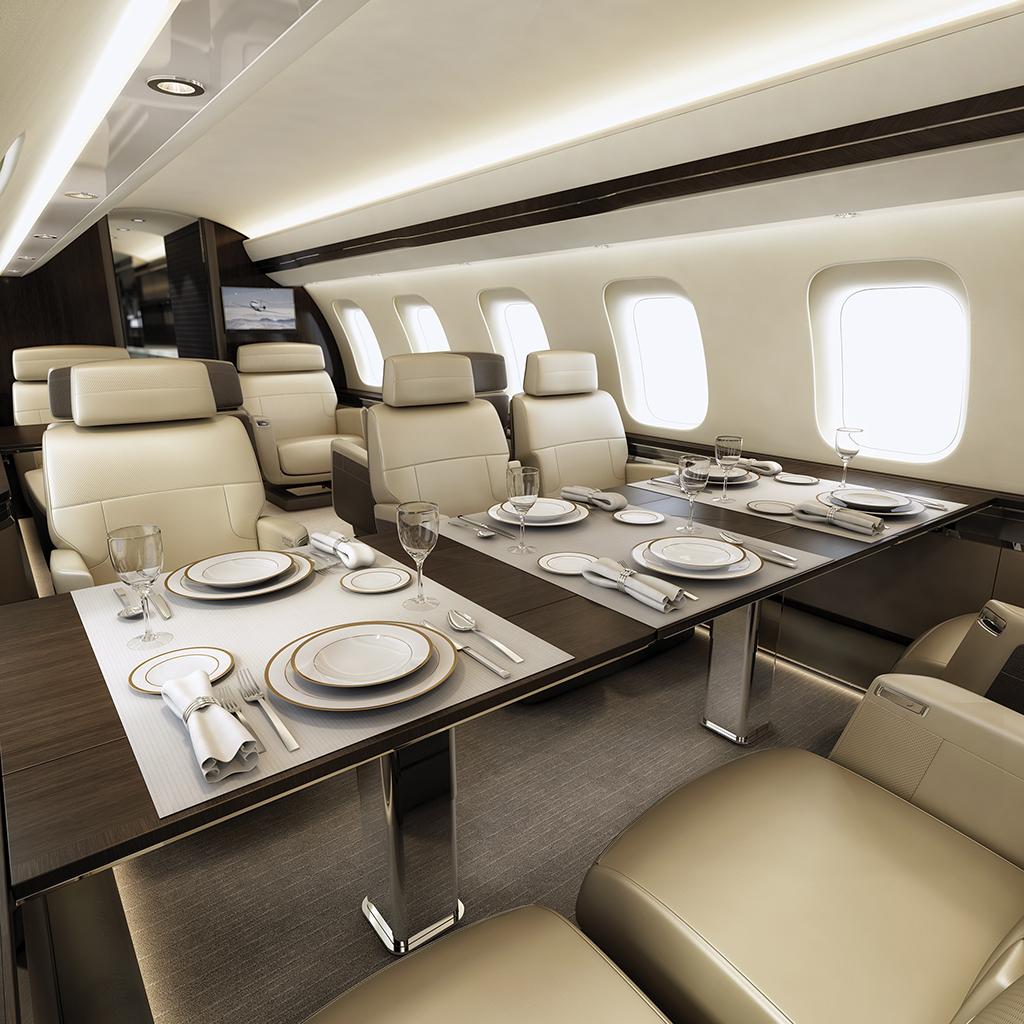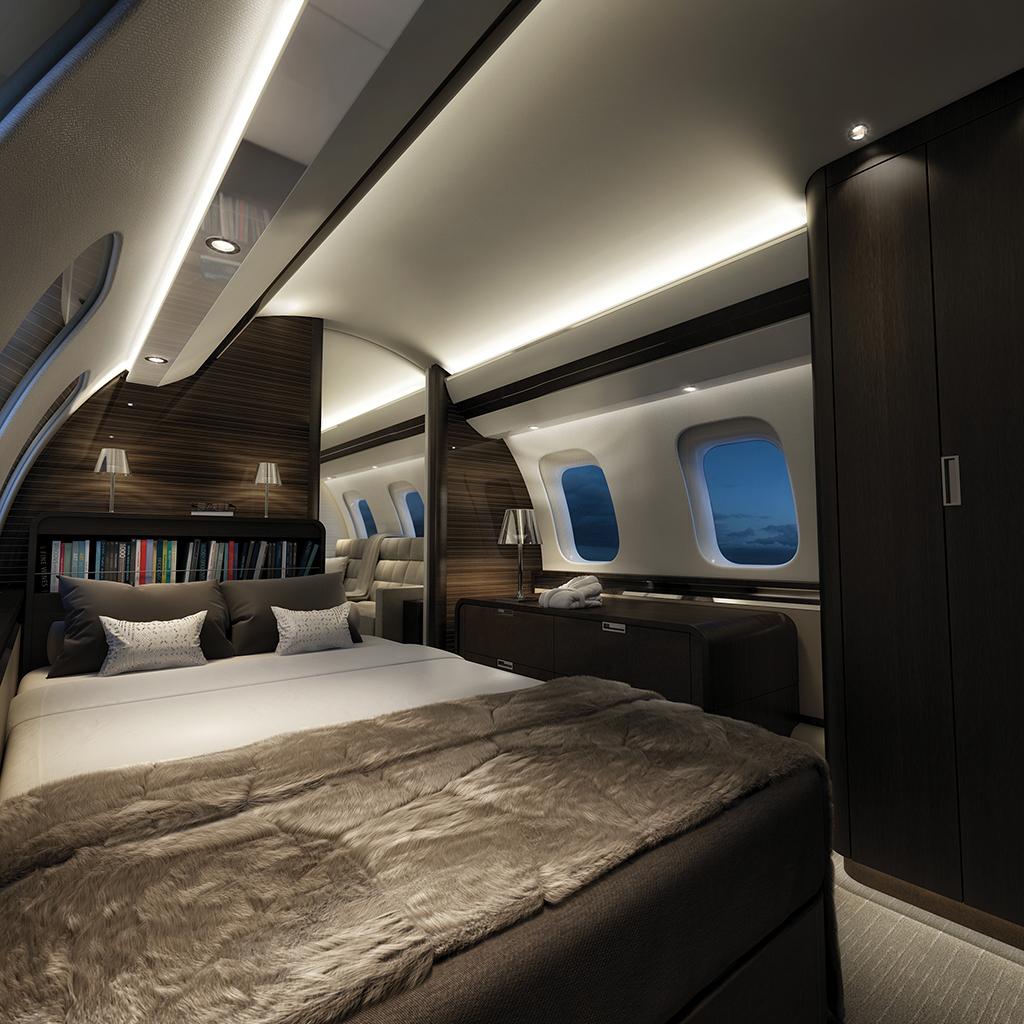
Walk around the Global 7500 and each time the sheer size and girth of this capacious Canadian cruiser always impresses. This flying Feadship is all about air supremacy, being the largest, heaviest and roomiest purpose-built business jet yet to enter production. It measures 111 ft. from nose to tail, spans 104 ft. and reaches 27 ft. in height, with a maximum ramp weight of more than 115,000 lb. That’s more girth than a Boeing 717 or BAC 1-11.
Unlike those liners, the Global 7500’s main mission is obviously not shuttling 130 to 150 commuters between Dallas and Denver or Seattle and San Francisco. Rather, the Bombardier flagship is designed to carry up to eight or nine people in unparalleled comfort on 16+ hr. transoceanic flights. Leave Tokyo at 5 p.m. and arrive in New York at 6 p.m. — on the same day. Three meals, two movies and one long, comfortable nap and you’re home from the Western Pacific in time for dinner.
The cabin is 12 ft. longer than the interior of a Global 6500, providing space for four cabin sections plus a full-size crew rest compartment up front. And it’s not just about what this luxury aircraft can do in the air, but how well it cossets passengers in the process.
This begins with offering them more cabin window area than any other large-cabin aircraft. The transparencies are substantially larger than the Airbus-size windows on other Globals, so the interior is flooded with bright ambient light. Bombardier’s Soleil cabin lighting system automatically adjusts the intensity and color of the interior lights throughout the flight to help passengers adjust to time zone changes by simulating day, dusk, night and dawn ambient light conditions.

The aircraft we flew for this report is no stripped-down, baseline model. It’s loaded with luxury options, including wine refrigerator, chiller and freezer, plus warming drawer, coffee and espresso makers and a full complement of top-end crystal, china and flatware. The galley has wood-veneer flooring and there’s stone-veneer flooring in the aft lavatory. The forward, or Zone 1, club suite has four oversized, plush, ergonomically shaped Nuage chairs. The Zone 2 six-seat conference suite area has a table that can be extended the full width of the cabin and chairs that move sideways for ample elbowroom at mealtime.
Zone 3 is the entertainment suite, complete with Bombardier’s signature 1,275-watt, multi-speaker l’Opera audio system, media center storage unit and 32-in. HD monitor plus three-place divan. The master suite in Zone 4 has a twin-size bed and single-chair executive workstation. The aft “en suite” lavatory may be equipped with optional shower.
Others may choose a different cabin configuration. In fact, this ultimate Global has a modular cabin design that enables buyers to pick and choose different layouts for each of the four 9-ft. seating areas, providing a choice of 10,000 distinctive floor plans. A corporate flight department, for instance, might choose back-to-back, four-chair club sections in Zone 1 and 2, swap out the entertainment suite for a conference grouping and install a three-place divan plus single chair for Zone 4.
Standard equipment includes a Honeywell JetWave 15-Mbps Ka-band satcom, voice and FANS over Iridium satcom, Lufthansa Technik Nice cabin management and IFE system, six external videocams, plus two media centers with hard disc AVOD storage and Blu-ray Disc players, 24-in. HD screen in the club suite, along with HDMI ports in the club and entertainment suites, and front and rear wireless access points. Pick up your mobile phone, enable Wi-Fi calling and the Ka-band satcom will connect you with anybody on the ground virtually any place you’re likely to fly.

With all this luxury kit, basic operating weight balloons to 61,700 lb. Yet, generous weight allowances still enable the aircraft to carry 1,890 lb. with full fuel. As a result, the fully equipped demonstrator aircraft has been able to rack up its share of range and speed records, including an 8,225-nm run from Sydney to Detroit.
The aircraft typically cruises at Mach 0.85 or 488 KTAS in the mid- to high forties, essentially the same speed as the latest long-range jetliners from Airbus and Boeing, but at considerably higher altitudes. It also can dash between Tokyo and New York at Mach 0.90.
However, our goal in flying the Global 7500 earlier this year wasn’t to press its speed, altitude or range limits. Rather, it was to probe its low-speed capabilities, its maneuverability, its handling characteristics, its advanced high angle of attack (AOA) protections. We soon learned there’s a world of difference between the Global 7500 and most competitors.
15,000 Ft. and Below
We belted in the left seat of serial number 70006 at California’s Norman Y. Mineta San Jose International Airport (KSJC) with Bruce Duggan in the right seat as instructor pilot and Michael Goggins on the jump seat as safety pilot. Zero fuel weight with three of us aboard and 100 lb. of supplies was 61,830 lb. Ramp weight was 80,080 lb. with 18,250 lb. of fuel, sufficient to fly from the Bay Area to Stephenville, Newfoundland.
Computed takeoff weight was 79,600 lb. Using Flaps 2 and de-rated thrust on that 14C day with a 6-kt. tailwind, takeoff field length was 4,066 ft. The V1 takeoff decision speed was 108 KIAS, rotation was 109 KIAS and the V2 one-engine-inoperative takeoff safety speed was 124 KIAS. Vfto final segment “clean wing” speed was 170 KIAS. We set the pitch trim at 5.5-deg. nose up as computed by the FMS for our weight and CG.

However, we could have shortened TOFL to 3,500 ft. by using Flaps 3, full-rated thrust and correspondingly lower V speeds, assuming we departed Runway 12R. The 1,254-sq.-ft. wing is smaller in area than that of the Gulfstream G700, but the Global 7500’s high-lift system, including leading-edge slats and double-slotted inboard Fowler flaps, gives the aircraft the best sea-level, standard-day runway performance of any aircraft in its class.
EFIS color conventions and clear, simple symbology also are best in class, in BCA’s opinion. Cyan signifies pilot input, magenta is for computer-generated targets, green shows active and short-range navigation modes, and white indicates standby or armed modes. The FMS is quite versatile and capable, but as with most modern avionics suites, mastering it is the most challenging aspect of learning the aircraft.
Once we nudged the thrust levers to move us out of the chocks, the lightly loaded aircraft only required idle thrust to keep moving at a brisk taxi speed. We found it helpful to deploy one thrust reverser to control taxi speed without having to ride the brakes. The nosewheel steering tiller provides 82.5 deg. of authority while +/-9 deg. is available through the rudder pedals.
When we were cleared for takeoff on Runway 30L, I armed the autothrottles, advanced the thrust levers and they engaged at about 60% N1 (fan speed) rpm. Pitch response, using the sidestick, was crisp but well damped, as one might expect from a well-sorted digital flight control system. The Global 7500 uses the fly-by-wire (FBW) system developed for the Airbus A220 (nee Bombardier CSeries), incorporating C*U speed stable control law. A trim switch atop the sidestick sets the neutral trim speed on normal law and it’s depicted on the airspeed tape as a cyan arrow. On the ground, the trim switch directly adjusts horizontal stabilizer trim position.

The biggest difference in control response between the Airbus A220 and Global 7500 is the sportier thrust-to-weight ratio of the business jet. Duggan advised me to stay on top of the need to trim the aircraft by anticipating rapid acceleration.
The FBW system eliminates pitch aberrations induced by configuration change. As Duggan retracted the landing gear, then selected Flaps 1, followed by Flaps 0, there was virtually no change in pitch attitude.
We flew the TECKY3 departure to TECKY intersection then eastbound to Friant VOR in the Sierra Nevada foothills via NTELL intersection. The autothrottles handled the thrust setting chores. Duggan requested a 14,000- to 16,000-ft. altitude block for airwork.
Warm-ups started with some garden variety, hand-flown/hand-throttle 45-deg. bank turns at 200 KIAS. Gentle lateral pressure on the sidestick rolls the aircraft at the comfortable, stately rate desired by carriage-class customers. The flight path vector on the PFD makes it easy to hold altitude during such conventional maneuvers. The sidestick controller has soft stops that assure the aircraft remains inside the published flight envelope.

Later, we slammed the sidestick to the hard stop to push the big bird close to the stall limit and it instantly seemed to shed its bulk and respond as though it were a lightly loaded Learjet. Had we paying passengers in the cabin, we would have been updating our resumés shortly after landing.
Then, we slowed the aircraft, extended gear and Slats/Flaps 4 (landing configuration) and bugged landing speed at 125 KIAS, about 6 to 7 kt. above Vref for the actual aircraft weight of 78,400 lb. We rapidly rolled into left and right 45-deg. bank angles, pulling 1.7g to maintain aircraft altitude. The aircraft remained fully controllable with no hint of stall warning buffet.
Next, we returned to wings level, disconnected the autothrottles and slowed to Vate, the lowest allowable trim speed, at a weight of 78,300 lb., for an envelope protection demonstration. At 116 KIAS, stabilizer trim was disabled, the autothrottle system automatically re-engaged and added full thrust to prevent the aircraft from decelerating.
We manually disengaged the autothrottles and pulled back the sidestick to the first, or soft, stop, the point at which the edge of the normal flight envelope is reached. The FBW system reined in allowable roll rate in response to the increased AOA to assure the aircraft didn’t depart controlled flight. We continued to pull back the sidestick to the hard stop, causing the stick shaker to activate and an aural “STALL, STALL” warning to be triggered. The FBW system nudged over the nose to prevent reaching aerodynamic stall and also restricted the bank angle to a few degrees left or right of wings level.

Our last maneuver was a demonstration of maximum bank angle available at low speed. With gear and Slats/Flaps 4 extended, we slowed to a Vref speed of 124 KIAS. We started a series of progressively tighter wind-up turns. As the aircraft approached 60-deg. angle of bank, the avionics system automatically bumped up Vref by 6 kt., to 130 KIAS. We weren’t quite able to maintain aircraft altitude at 2g at that speed with the stick pulled back to the soft stop. But the aircraft remained fully controllable, giving complete confidence that it could be maneuvered in such an extreme way if the situation warranted it.
Following the airwork maneuvers, we returned to San Jose for landing. Vref at 76,400 lb. was 116 KIAS and landing distance was 2,443 ft. Total flight time was 0:53 min.
Benefits of Low-Speed Agility
The Global 7500 responds more like a Ferretti sport yacht than a stately Feadship in terms of agility. Most crews never will need to press the aircraft to its limits. But flying the aircraft to the low-speed edges of the flight envelope instills plenty of confidence in its capabilities, should the need arise.
Weather conditions at destination airports can change radically during the course of a 16-hr. flight. At times, the weather at divert airports seems to deteriorate in keeping with Murphy’s law. When clouds darken, turbulence kicks up and low-altitude wind shear arises, flight crews can feel confident in this aircraft’s crisp control response and flight envelope protections. The jet seems capable of handling just about anything Mother Nature can throw at it, short of a black swan microburst or Texas tornado.
Few business aircraft we’ve flown in this class, indeed in any class, handle better at low speed than the Global 7500. However, size and stoutness still matter regarding permission to land and take off. There are many landing facilities that don’t have pavement that’s strong or wide enough to accommodate such large aircraft. The Global 7500 may be sufficiently nimble to navigate around storms and peaks in the Rockies, but it’s not welcome at Aspen-Pitkin County Airport/Sardy Field (KASE) due to its 104-ft. wingspan. And, it can circle to land tight-in at Teterboro in stiff crosswinds, but it’s limited to operating weights of 100,000 lb. or less by airport rules. Even with the 100,000 lb. limitation, it can depart Teterboro and fly 5,650 nm.
Bombardier has redefined expectations for large-cabin aircraft with this Global, spurring strong competition from Savannah and St. Cloud. Development of Gulfstream’s four-section-cabin G700 is proceeding amain. Its net cabin size, speed and range will offer the Global 7500 hot competition. Lacking leading-edge slats, though, its low-speed performance won’t be in the same league.
Later this year or in early 2021, Dassault is expected to launch the Falcon 9X, its largest, fastest, longest-flying business jet. It’s expected to have the lightest weight airframe in class, along with full-span slats and digital flight controls. Thus, its low-speed handling should be unsurpassed. Meeting or beating best-in-class range and speed numbers will be its biggest challenge.
For now, however, the Global 7500 offers an unmatched blend of cabin comfort and convenience, speed and range, low-speed agility and handling ease. It’s in the lead and others are running hard to catch it.
EDITOR'S NOTE: The Global 7500's limitations at Teterboro were clarified.






Comments